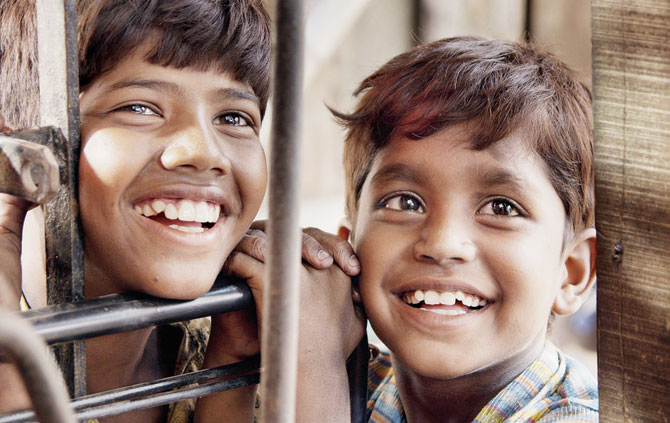Manikandan’s debut flick Kaaka Muttai (Crow’s Egg) – a new-sprung fable that delighted all of its audience both aesthetically and emotionally with the gist sprinkled dose of social realism, innocence, satire and sadness that all embodied with human desire.
It’s a simple anecdotes of two slum-hood siblings Chinna Kaaka Muttai (small crow’s egg) and Periya Kaaka Muttai (Big crow’s egg) poignant hunt to taste a slice of pizza against all their odds and as seeing their father jailed in prison; mother (beautifully portrayed by, Aishwarya Rajesh) as a meagre worker, who’s trying to release her husband from prison and cannot afford her kids to send to school. There is so much beauty here, as when the duo gather pieces of coals that scattered across the railway track and sell it for mere pittance and give it to their mother who’s saving it for her husband release. The bond of the two siblings and the dote they share with their mother and grandma seemed to be joie de vivre and yet we may find poignancy when they smile.
The first scene of the film was a little surprise for me as it features a kid wets/urinate. Sergio Leone’s “Duck you sucker” is the last film I remember of that does the same, where an unpleasant closeup shot of Rod Steiger urinating on some ants. But here its different and perfectly fitted because of the Small Egg’s playfulness to hide his wearing shirts in the nearby utensil before it reaches his mother’s hand. The film has several memorable scene that one often reminiscent about such as, when “Big Egg” place cooked rice into his pocket and go to the nearby open ground’s tree with a crow’s nest on it and the “Small Egg” chant the ka ka ka…. tone to bewilder the bird and help his elder brother to climb the tree and to pick up the crow’s egg.
There’s unbearable pathos and humour were lurking behind the two siblings performance like the scene where the duo try to sell their stray dogs for 25,000 without the slightest clue about why pug is more saleable and its causes more melancholy than it’s sound of cultural materialism and high breed consumerism.
However, the film is not just being in the limelight of kids poignant hunt the story. It even moves further and wended its way into social realistic situation as when the kids mother gets a freely provided TV from the ration shop and another TV was already in their house. Which she answered that “no stock in the ration shop” – means ration shop has enough TVs than rice, a bit of sarcasm that filmmaker gently sprinkled throughout the end. And the filmmaker, Manikandan effortlessly crafted the poignant hunt story with wit into social realistic elements and human desire in multiple form as the siblings desire to taste a pizza, mother desire to release her husband from prison and Politicians greediness and even the effects of globalization, satire on media’s obsession when the owner of the pizza turns into messiah when he offers the kids free pizza for life is clearly shows the media sensationalism that we are part of. And also the rich and poor shown explicably without cross the cheesy borders that never lets slide into hostile, for example, when “Big Egg” was reluctant to settle with pizza slice that offered by the neighbours and it also has lesson of hardship to achieve the goal. Though the involvement of Ramesh Thilak subplot seems little inessential but in the scene where demands money in exchange for the video recording with a childlike witty portrayal holds true to the script and it merely well to the audience.
After watched this movie, I have tried to resemble the film with Ray’s Pather Panchali as it possess the same identity in its setting and situation in which I utterly failed in every way because the film itself was inspired by watching poor kids and their lives but I did hope that the filmmaker were able to conjure up something wonderful here that totally left me in a gasp of wonderment.
In every which way its way far better film than Danny Boyle’s “Slumdog Millionaire” which shown the Delhi slum-hood live as a “fairy tale,” “poverty porn” and seeks sympathy from its audiences whereas Kaka Muttai stands tall and true in many form of class divide, racism and global corporate consumerism on the poor. And the score added well-nigh freshness that doesn’t let it take over the film plot.
In that area, when the duo go beyond the great challenge to hunt for a pizza, they decide to save up enough to go to pizza shop and eat a pizza from picking coal on the rail track here the filmmaker seems to have understood the class and leaves it to the audience to interpret it.
Overall, without no exaggeration, Kaaka Muttai is a rare brand of cinema and a lovely symbolism of modern day Pather Panchali and yet it leaves a lucid question at the both end and the beginning of the film – the Paati (the sibling’s grandma) questions why the crow’s egg supposed déclassé to other eggs, lacking the taste of chicken? or just because the crow is black? – Which I believe could be the inspiration for the title as “Kaaka Muttai.”
